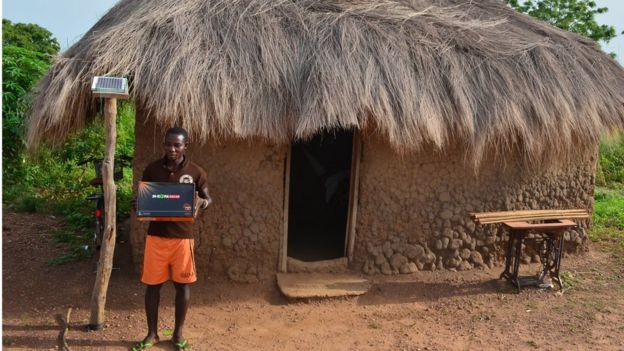How do you charge your phone when the sun doesn't shine?
Seeing our mobile phone running low on juice can induce near panic in many of us these days - we've become so reliant on them.

So imagine what it's like living in a remote village whose only electricity comes from solar power. What do you do when the sun doesn't shine?
Not only might your phone die, you might not have enough stored electricity to keep the lights on for more than a few hours. You have to light candles or a smelly kerosene lamp to see what you're doing at night.
But one solar power firm, Azuri, reckons it has an answer to this problem.
Its HomeStart system learns your electricity usage patterns and monitors climatic conditions to make sure the stored solar power is used in the most efficient way.
 PEG GHANA
PEG GHANA
This can involve dimming lights to use less power and generally eking out the stored energy on less sunny days.
"Standalone solar home systems run until the power stored from sunshine during the day is exhausted, and then switch off," says Simon Bransfield-Garth, Azuri's chief executive.
"In poor weather, this may mean lighting time is reduced to just a few hours, forcing customers to revert to traditional means, such as harmful kerosene."
Health and education
The firm believes this is the first time machine learning has been applied to rural domestic solar power systems, and is an example of how innovation in the solar sector is helping "off-grid" households power up more efficiently across the continent.
New products are coming on to the market, including solar-powered fans, TVs and fridges.
One firm, Aleutia, provides a "solar classroom in a box", including solar panels, 10 rugged computers, a server, LED projector, and 3G and satellite networking equipment. It costs about $9,500 (£7,100).
 ALEUTIA
ALEUTIA
Aleutia has provided 137 schools in Uganda with computers and education software.
The company has also launched SolarEnabler, a "plug-and-play" box that provides everything you need for solar power in a wall-mounted box with constant 2G connectivity.
"Our computers are unique in their incredibly low energy consumption, which makes solar affordable," says Michael Rosenberg, Aleutia's chief executive.
It is making a big difference in rural primary health centres, he says.
"A single computer can register 800 patients a month, and record their symptoms and conditions. It is solar-powered hardware that provides transformative big data for health ministries."
Pay-as-you-go
Innovation in financing has also been key to the growing adoption of solar energy.
"Pay-as-you-go" and "rent-to-buy" schemes, pioneered by the likes of M-Kopa Solar and Azuri, are helping households pay off the cost of the solar kit over a manageable period.
Customers use mobile money services like M-Pesa to credit or top up their solar accounts.
 AZURI
AZURI
"Over the course of typically 18 months, the purchase of top-up pays off the cost of the solar home system," says Mr Bransfield-Garth.
"After this, the customer fully owns the system and can use it to access clean, renewable energy with no further cost."
Azuri, which launched in Kenya and has since expanded to other countries, has sold about 80,000 solar home systems so far.
Its entry level solar panel is a five-watt unit which, with plenty of sun beating down, provides users with about eight hours of lighting for two rooms and mobile phone charging.
 PEG GHANA
PEG GHANA
It costs about 220 Kenyan Shillings a week (£1.62; $2.17).
"Azuri's objective is to deliver clean and affordable power to enable rural Africans to realise their aspirations; lighting and mobile phone charging are just the starting point," says Mr Bransfield-Garth.
From light to credit
PEG Ghana, another solar power firm, has connected almost 15,000 homes in the West African country via a pay-as-you-go model and a kit made up of two lamps, a radio, a torch, and a mobile phone charger.
"We enable customers to replace their perpetual spending on poor-quality polluting fuels, such as kerosene, with solar energy that quickly becomes an asset the customer owns," says Nate Heller, chief executive of PEG Ghana.
 PEG
PEG
And the firm now offers customers who have paid off their solar units loans for other items, such as smartphones.
"Before you buy our product, you have a challenge to get anything on credit. You live in the middle of nowhere, you have no credit history, and no collateral," Mr Heller says.
"After you've paid off our system we have one year's worth of data on how you paid off the loan. Now we can give you loans for things like smartphones - you are a safe credit risk," he says.
Business case
But about 585 million people still lack access to electricity in Africa, according to the International Energy Agency, with only 14.2% of people in rural areas able to power their homes.
Even those with access to regular grid power can find it unreliable.
This leaves millions having to rely on kerosene, candles, battery torches or other fossil-fuel powered technologies.
 AZURI
AZURI
Across Africa and Asia, the 1.2 billion people who have no access to electricity spend about $27bn (£20.4bn) annually on these alternatives, says the BNEF Global Solar Market Trends Report 2016.
Solar power could save them a lot of money.
So the case for taking solar power into poorer communities is not just a social policy issue, says Xolani Mncedane, senior research analyst at the consultancy Frost & Sullivan Africa.
There is now a "compelling business case", he says. "The market is more affordable and more appealing.
"Solar home systems and solar-diesel hybrid systems are becoming economical, thereby presenting new opportunities, new business approaches and new financing models," concludes Mr Mncedane.
No comments:
Post a Comment